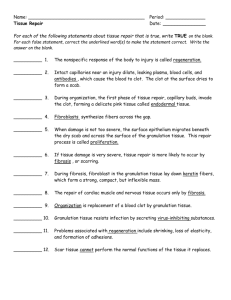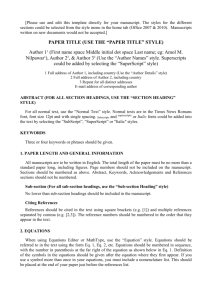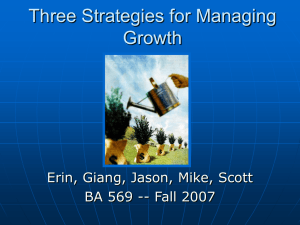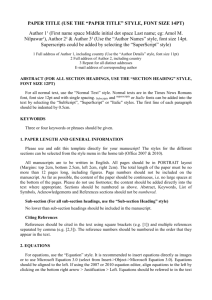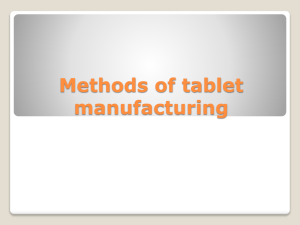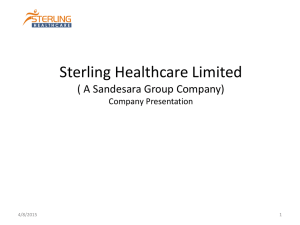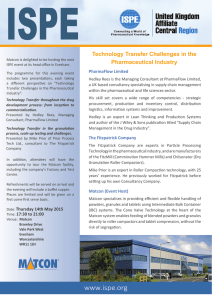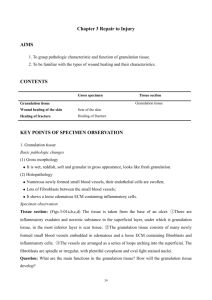Document 13308369
advertisement
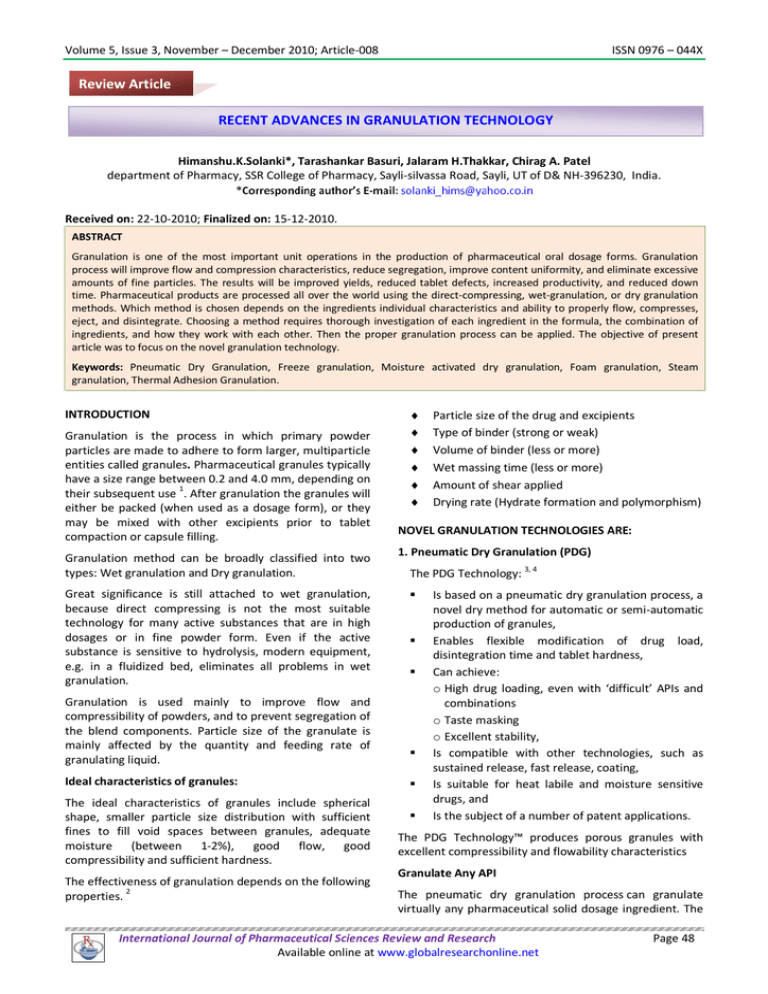
Volume 5, Issue 3, November – December 2010; Article-008 ISSN 0976 – 044X Review Article RECENT ADVANCES IN GRANULATION TECHNOLOGY Himanshu.K.Solanki*, Tarashankar Basuri, Jalaram H.Thakkar, Chirag A. Patel department of Pharmacy, SSR College of Pharmacy, Sayli-silvassa Road, Sayli, UT of D& NH-396230, India. Received on: 22-10-2010; Finalized on: 15-12-2010. ABSTRACT Granulation is one of the most important unit operations in the production of pharmaceutical oral dosage forms. Granulation process will improve flow and compression characteristics, reduce segregation, improve content uniformity, and eliminate excessive amounts of fine particles. The results will be improved yields, reduced tablet defects, increased productivity, and reduced down time. Pharmaceutical products are processed all over the world using the direct-compressing, wet-granulation, or dry granulation methods. Which method is chosen depends on the ingredients individual characteristics and ability to properly flow, compresses, eject, and disintegrate. Choosing a method requires thorough investigation of each ingredient in the formula, the combination of ingredients, and how they work with each other. Then the proper granulation process can be applied. The objective of present article was to focus on the novel granulation technology. Keywords: Pneumatic Dry Granulation, Freeze granulation, Moisture activated dry granulation, Foam granulation, Steam granulation, Thermal Adhesion Granulation. INTRODUCTION Granulation is the process in which primary powder particles are made to adhere to form larger, multiparticle entities called granules. Pharmaceutical granules typically have a size range between 0.2 and 4.0 mm, depending on their subsequent use 1. After granulation the granules will either be packed (when used as a dosage form), or they may be mixed with other excipients prior to tablet compaction or capsule filling. Granulation method can be broadly classified into two types: Wet granulation and Dry granulation. Great significance is still attached to wet granulation, because direct compressing is not the most suitable technology for many active substances that are in high dosages or in fine powder form. Even if the active substance is sensitive to hydrolysis, modern equipment, e.g. in a fluidized bed, eliminates all problems in wet granulation. Granulation is used mainly to improve flow and compressibility of powders, and to prevent segregation of the blend components. Particle size of the granulate is mainly affected by the quantity and feeding rate of granulating liquid. Ideal characteristics of granules: The ideal characteristics of granules include spherical shape, smaller particle size distribution with sufficient fines to fill void spaces between granules, adequate moisture (between 1-2%), good flow, good compressibility and sufficient hardness. The effectiveness of granulation depends on the following properties. 2 Particle size of the drug and excipients Type of binder (strong or weak) Volume of binder (less or more) Wet massing time (less or more) Amount of shear applied Drying rate (Hydrate formation and polymorphism) NOVEL GRANULATION TECHNOLOGIES ARE: 1. Pneumatic Dry Granulation (PDG) The PDG Technology: 3, 4 Is based on a pneumatic dry granulation process, a novel dry method for automatic or semi-automatic production of granules, Enables flexible modification of drug load, disintegration time and tablet hardness, Can achieve: o High drug loading, even with ‘difficult’ APIs and combinations o Taste masking o Excellent stability, Is compatible with other technologies, such as sustained release, fast release, coating, Is suitable for heat labile and moisture sensitive drugs, and Is the subject of a number of patent applications. The PDG Technology™ produces porous granules with excellent compressibility and flowability characteristics Granulate Any API The pneumatic dry granulation process can granulate virtually any pharmaceutical solid dosage ingredient. The International Journal of Pharmaceutical Sciences Review and Research Available online at www.globalresearchonline.net Page 48 Volume 5, Issue 3, November – December 2010; Article-008 ISSN 0976 – 044X granulated material has exceptionally good flowability and compressibility properties. PDG Technology has been used with superior results in developing fast-release, controlled-release, fixed-dose, and orally disintegrating tablets. The technology is applicable to practically any solid dosage pharmaceutical product. 5 Pneumatic Dry Granulation Replaces Wet Granulation Today, wet granulation is the most commonly used granulation method. Formulation teams will usually target a direct compression or dry granulation formulation where possible but in approximately 80% of the cases they end up with a wet granulation formulation due to processing issues. Figure 1: PDG comparison Technology and wet granulation Lower cost of manufacturing compared with wet granulation, The system is closed offering safety advantages due to low dust levels and potential for sterile production or handling of toxic materials, The end products are very stable - shelf life may be enhanced, Little or no waste of material, Scale-up is straightforward, The granules and tablets produced show fast disintegration properties, offering the potential for fast release dosage forms, and Release time can be tailored to requirements. Benefits to Pharmaceutical Companies PDG Technology is the key solution to challenges faced by pharmaceutical companies in development of solid oral dosage forms. The technology replaces existing solid dosage form development and manufacturing technologies, offering more rapid development and better quality. The unique capabilities of the technology have been demonstrated in number of evaluation studies with top-tier pharmaceutical companies. 7, 8 2. Freeze granulation Technology Wet granulation is also unsuitable for moisture sensitive and heat sensitive drugs, it is more expensive than dry granulation, it is relatively labour intensive and can take a long time. There are a large number of process steps and each step requires qualification, cleaning, and cleaning validation, high material losses can be incurred because of the transfer between stages, there is the need for long drying times. Scale up is usually an issue, and there are considerable capital requirements. PDG Technology solves the above problems. 6 PDG Technology granules have excellent properties compared to wet granulation, dry granulation and direct compression. At the same time, the granules show both high compressibility and flowability. The results can be archived without using exotic and expensive excipients. 7 Advantages of PDG Technology The PDG Technology has a number of advantages to support the above claims including the following: Good granulation results even at high drug loading have been achieved even with materials known to be historically difficult to handle, Faster speed of manufacturing compared with wet granulation, Swedish Ceramic Institute (SCI) has adopted and developed an alternative technique – freeze granulation (FG) – which enables preservation of the homogeneity from suspension to dry granules 9 By spraying a powder suspension into liquid nitrogen, the drops (granules) are instantaneously frozen. In a subsequent freeze-drying the granules are dried by sublimation of the ice without any segregation effects as in the case of conventional drying in air. The result will be spherical, free flowing granules, with optimal homogeneity. 10 Figure 2: Freeze granulation FG provides optimized condition for the subsequent processing of the granules, for example easy crushing to homogeneous and dense powder compacts in a pressing operation. High degree of compact homogeneity will then support the following sintering with minimal risks for 14 granule defects. Besides, high degree of granule homogeneity, FG offers 11 several other advantages: International Journal of Pharmaceutical Sciences Review and Research Available online at www.globalresearchonline.net Page 49 Volume 5, Issue 3, November – December 2010; Article-008 Control of granule density by the solids content of the suspension. Mild drying prevents serious oxidation of non-oxides and metals. No cavities in the granules. Low material waste (high yield). Small (50–100 ml suspension) as well as large granule quantities can be produced to equal quality. Easy clean of the equipment (latex binder can be used). Possibility to recycle organic solvents. The granule size distribution will be controlled by the suspension rheology (flow properties) and the process parameters (pump speed and air pressure). Normally, a certain size distribution-width is achieved with an average size, typically, around 100–200 µm. Several companies and research labs around the world have applied the freeze granulation process with the support of PowderPro. Typical ceramic powders are oxides (Al2O3, ZrO2, and SiO2), nitrides (Si3N4) and carbides (SiC), but also nanopowders, diamonds and pharmaceuticals like proteins and enzymes. 12, 13 3. Foamed Binder Technologies (FBT) Foamed binder technology from The Dow Chemical Company can help you achieve faster, simpler, and safer wet granulation processing.15 Using familiar, proven METHOCEL polymers, this technology greatly improves binder distribution in the formulation mix and yields a remarkable array of processing advantages.16 Compared to conventional spray processing, foamed binder technology can shorten processing times by reducing water requirements. It can improve reproducibility through more uniform binder distribution. Moreover, it eliminates spray nozzles and their many variables in granulation processing equipment. Foam processing also offers better end point determinations and reduced equipment clean-up time. While foamed binder processing offers many advantages, this technology doesn’t demand new equipment or radical changes in processing techniques. You can very easily use it with familiar high shear, low shear, or fluid bed granulation equipment, in both laboratory- and production-scale settings.17 Our evaluations also show it yields familiar metrics for particle size distributions, solid dose physical properties, and dissolution profiles. How foam binder granulation works ISSN 0976 – 044X hypromellose (hydroxypropyl methylcellulose). The resulting foam has a consistency like shaving cream. Hypromellose polymers are ideal candidates for this technology because they are excellent film formers and create exceptionally stable foams. In a small-scale laboratory setting or in a full-scale production setting, the foam generator can be connected directly to high-shear, low-shear, or fluid bed granulation equipment. 18 Extremely efficient binder delivery and particle coverage The key to the effectiveness of foam binder performance is rapid and extremely efficient particle coverage. Compared to sprayed liquid binders, foamed binders offer much higher surface area, and they spread very rapidly and evenly over powder surfaces. The foamed binders and the powder particles show excellent mutual flow through one another. The foam binder also shows a low soak: spread ratio, so particle surfaces are quickly and completely covered. By contrast, spraying is a cumulative process that begins with small liquid droplets “dappling” particle surfaces until enough binder liquid accumulates to initiate particle agglomeration. Spraying requires considerably more water and processing time than a foamed binder to achieve particle agglomeration. The foam binder technology also eliminates the need for spray nozzles and all of their attendant variables, such as nozzle configuration, distance from the moving powder bed, spray patterns, clogging, droplet size, and droplet distribution. The dilute binder solutions are easy to handle in processing. Overall, foam binder processing is easier, faster, and allows safer handling of potent drug compounds. 19 4. Melt Granulation Technology Melt granulation is processes by which granules are obtained through the addition of either a molten binder or a solid binder which melts during the process. This process is also called melt agglomeration and thermoplastic granulation. Principle of melt granulation: The process of granulation consists of a combination of three phases: I. II. III. Wetting and nucleation, Coalescence step, Attrition and breakage. Foam granulation takes advantage of the tremendous increase in the liquid surface area and volume of polymeric binder foams to improve the distribution of the water/binder system throughout the powder bed of a solid dose pharmaceutical formulation. Wetting and nucleation step: A simple foam generation apparatus is used to incorporate air into a conventional water-soluble polymeric excipients binder such as METHOCEL Two nucleation mechanisms are proposed by Schafer and Mathiesen. • During the nucleation step the binder comes into contact with the powder bed and some liquid bridges are formed, leading to the formation of small agglomerates. International Journal of Pharmaceutical Sciences Review and Research Available online at www.globalresearchonline.net Page 50 Volume 5, Issue 3, November – December 2010; Article-008 I. II. Immersion Distribution ISSN 0976 – 044X o A Meltable binder suitable for melt a granulation has a melting point typically within the range of 50– 100_C. o Hydrophilic Meltable binders are used to prepare immediate-release dosage forms while the hydrophobic Meltable binders are preferred for prolonged-release formulations. o The melting point of fine solid particles should be at least 20°C higher than that of the maximum processing temperature. Immersion Nucleation by immersion occurs when the size of the molten binder droplets is greater than that of the fine solid particles. Immersion proceeds by the deposition of fine solid particles onto the surfaces of molten binder droplets. Figure 3: Modes of melt agglomeration: Immersion Distribution: In the distribution method a molten binding liquid is distributed onto the surfaces of fine solid particles. The nuclei are formed by the collision between the wetted particles. Generally, small binder droplet size, low binder viscosity, and high shearing forces are favorable conditions for nucleation by the distribution method Figure 4: Modes of melt agglomeration: Distribution Coalescence step: It involves nuclei that have residual surface liquid to promote successful fusion of nuclei. The surface liquid imparts plasticity to the nuclei and is essential for enabling the deformation of nuclei surface for coalescence as well as promoting the rounding of granulation. Attrition-breakage step: Attrition and breakage refer to the phenomenon of granulation fragmentation in that are solidified by tray cooling to ambient temperature without the need for drying by a tumbling process. Consequently, breakage is known to have a more essential role in affecting the resultant properties of the melt granulation during the granulation phase. Requirements of melt granulation: o Generally, an amount of 10–30% w/w of meltable binder, with respect to that of fine solid particles, is used. Meltable binders: o It must be solid at room temperature and melt between 40 and 80°C, o Its physical and chemical stability o Its hydrophilic-lipophilic balance (HLB) to ensure the correct release of the active substance. o There are two type of Meltable binder 1) Hydrophilic Meltable binders 2) Hydrophobic Meltable binder Advantage of melt granulation: • Neither solvent nor water used. • Fewer processing steps needed consuming drying steps eliminated. • Uniform dispersion of fine particle occurs. • Good stability at varying pH and moisture levels. • Safe application in humans due to their non-swell able and water insoluble nature thus time The melt granulation process carries several advantages over conventional pharmaceutical granulation methods, as the process does not require the use of solvents. A further significant advantage of melt granulation is that judicious choice of the granulation excipient may enable the formulator to manipulate the drug dissolution rate 20 from the corresponding dosage form The melt granulation process uses a substances that melt at relatively low temperature (i.e., 50-800C). These substances can be added to the molten form over the substrate or to a solid form, which is then heated above its melting points by hot air or by a heating jacket. In both cases, the substance acts like a liquid binder after it melts. Thus melt granulation does not require the organic or aqueous solvents. Moreover the drying step is not necessary in melt granulation, thus the process is less time consuming and more energy efficient than wet granulation. 21, 22 After selecting a suitable binder, one can use melt granulation to prepare controlled release or improved release granules. Polyoxyl stearates may be considered as potentially useful hydrophilic binders in melt granulation. When water soluble binders are needed, Polyethylene International Journal of Pharmaceutical Sciences Review and Research Available online at www.globalresearchonline.net Page 51 Volume 5, Issue 3, November – December 2010; Article-008 23 Glycol (PEG) is used as melting binders. When water insoluble binders are needed, Stearic acid, cetyl or stearyl alcohol, various waxes and mono-, di-, & triglycerides are used as melting binders. 5. Steam Granulation • It is modification of wet granulation. Here steam is used as a binder instead of water. • In this method of granulating particles involves the injection of the required amount of liquid in the form of steam. • This steam injection method, which employs steam at a temperature of about 150° C., tends to produce local overheating and excessive wetting of the particles in the vicinity of the steam nozzles, thereby causing the formation of lumps in the granulated 24 product. Advantage: Higher distribution uniformity, Higher diffusion rate into powders, Steam granules are more spherical, Have large surface area hence increased dissolution rate of the drug from granules, Processing time is shorter therefore more number of tablets are produced per batch, ISSN 0976 – 044X Compared to the use of organic solvent water vapor is environmentally friendly, Lowers dissolution rate so can be used for preparation of taste masked granules without modifying availability of the drug. 6. Moisture Activated Dry Granulation (MADG) • In this method moisture is used to activate the granules formation but the granules drying step is not necessary due to moisture absorbing material 25 such as MCC. • The moisture-activated dry granulation process consists of two steps, wet agglomeration of the powder mixture followed by moisture absorption stages. • A small amount of water (1–4%) is added first to agglomerate the mixture of the API, a binder, and excipients. Moisture absorbing material such as MCC and potato starch is then added to absorb any excessive moisture. 26 • After mixing with a lubricant, the resulting mixture can then be compressed directly into tablets. Hence, this process offers the advantage of wet granulation is that eliminates the need for a drying step. • MCC, potato starch, or a mixture of 50% of each was used as moisture absorbing material. Figure 5: Flow diagram of moisture activated dry granulation process FMC Biopolymer has introduced two new excipient products to the Pharma market: Avicel HFE-102 and Avicel PH-200 LM, which are based on already existing excipients but have been generated to produce a different entity with improved benefits. 27 Avicel PH-200 LM, based on microcrystalline cellulose (MCC), has been formulated to reduce the amount of water added to the granulation process Avicel PH-200 LM is a step up from FMC Biopolymer’s Avicel PH-200 which had a moisture level of five per cent. The new product has a moisture level of no more than 1.5 per cent and can International Journal of Pharmaceutical Sciences Review and Research Available online at www.globalresearchonline.net Page 52 Volume 5, Issue 3, November – December 2010; Article-008 absorb approximately three to four times as much water from the granule. This advantage, along with enabling the use of MADG, meant the use of Avicel PH-200 LM could eliminate the extra steps of milling, drying and screening, thereby reducing manufacturing costs and energy used. The process also produced a larger particle size for optimal flow. This increases efficiencies to the manufacturing process. It takes aspects of wet granulation but eliminates the drawbacks of it. Also be useful for the use of active pharmaceutical ingredients (APIs) which were sensitive to moisture. 28 Avicel HFE-102 is a new, proprietary co-spray dried MCC/mannitol high functionality binding excipient for direct compression. The co-spray drying added extra benefits to the excipient as it changed its properties combining the high compressibility of MCC and the low lubricant sensitivity of Mannitol. The outcome was a 29 harder, less friable and faster disintegrating tablet. Advantage: It utilizes very little granulating fluid. It decreases drying time and produces granules with excellent flow ability. Single production equipment (high shear granulator) No equipment change Lower tablet capping No over and under granulation 7. Granulex® Technology The Granurex® precisely and consistently performs both coating and powder layering processes. In the pictures to the right, multiple coating and powder (ingredient) layers demonstrate the accuracy and control of a Granurex® rotor processor, including the creation of the nonpareil. Key feature: Unique, Efficient Granulation Processes: Granules produced by the Granurex® are dense and spherical in shape. The pictures and graphs shown below demonstrate how the Granurex® processes Ciprofloxacin from a 7µm poorly flowing powder to 200µm granules with excellent flow characteristics. One Pot Processing: A patented feature of the Granurex® is its ability to dry product within the same processing chamber. This unique drying method, combined with 12 bar construction, provides a true one-pot system, ideal for manufacturing highly potent and expensive pharmaceutical compounds. Increased Batch Capacities: The patented conical rotor plate increases batch capacities when compared to traditional rotor processors. The precision machined gap contains the product within the processing area and the peripheral spray guns are embedded into the product, which provides accurate coating with minimal spraying defects. ISSN 0976 – 044X Maximum Process Flexibility: Using micronized acetaminophen as the base material, the Granurex® produced both a 100 µm granulation and a 200 µm spherical bead. In both of the examples below, the APAP core material had the same initial Mean Particle Size (X50) of 40 µm. 30 8. Thermal Adhesion Granulation Process (TAGP) It is applicable for preparing direct tabletting formulations. TAGP is performed under low moisture content or low content of pharmaceutically acceptable solvent by subjecting a mixture containing one or more diluents and/or active ingredients; a binder; and optionally a disintegrant to heating at a temperature in the range from about 30ºC to about 130ºC in a closed system under mixing by tumble rotation until the formation of granules. This method utilizes less water or solvent than traditional wet granulation method 31, 32 It provides granules with good flow properties and binding capacity to form tablets of low friability, adequate hardness and have a high uptake capacity for active substances whose tabletting is poor. In thermal adhesion granulation, granules are formed during mixing of the moist powder under continuous tumble rotation, as the heated powder mass flows within the container and agglomerates with the aid of the binder 2 Drying and milling to form the desired granules are unnecessary in the present invention due to the low amount of moisture introduced to the tabletting mixture. 33 Another major advantage of granulating pharmaceutical products in a closed system is that it helps to minimize the generation of dust during powder processing. This technique serves to contain fine-powder active ingredients whose spread or loss from the system is not desirable due to their cost or biological activity. 34 CONCLUSION These review works mainly focus on the novel granulation techniques to produce granule. Each technique has its own advantage and disadvantages. Which method is chosen depends on the ingredients individual characteristics and ability to properly flow, compresses, eject, and disintegrate. Choosing a method requires thorough investigation of each ingredient in the formula, the combination of ingredients, and how they work with each other. Then the proper granulation process can be applied. REFERENCES 1. Aulton M. Phamaceutics: The Science of Dosage Form Design. Edinburgh: Churchill Livingstone, 2000; 15–32. 2. www.pharmpedia.com/Tablet:Manufacturing_meth ods/Granulation 3. www.atacamalabs.com/technology_specialty International Journal of Pharmaceutical Sciences Review and Research Available online at www.globalresearchonline.net Page 53 Volume 5, Issue 3, November – December 2010; Article-008 4. 5. www.atacamalabs.com/pdg www. in-pharmatechnologist.com/ProductCategories 6. www.pharmalicensing.com/public/news/viewNews ML/4508 7. 8. www.technopolisonline.com www.excella-pharma-source.de 9. www.powderpro.se/ 10. www.powderpro.se/uploads/media/Brochure_Free ze_Granulation_2010.pdf 11. Rundgren K., Lyckfeldt O. and Sjöstedt M., Improving Powders with Freeze Granulation, Ceramic Industry, 2003, 40-44. 12. www.powderpro.se/uploads/media/Freeze_Granula tion_of_Nano_Materials_London_June_2010.pdf 13. www.keram.se/eng/pdf/frysgranulering_eng.pdf 14. www.sci.se resp. 15. www.dow.com/dowexcipients/resources/applicatio n/app_granulation.htm 16. Paul J., Shesky R., Colin K., New foam binder technology from Dow improves granulation process, Pharmaceutical Canada, June 2006;19-22. 17. Sheskey P. et al., "Foam Technology: The Development of a Novel Technique for the Delivery of Aqueous Binder Systems in High-Shear and FluidBed Wet-Granulation Applications," poster presented at AAPS Annual Meeting and Exposition, Salt Lake City, UT, Oct. 2003; 26-30. 18. Sheskey P. et al., "Scale-Up Trials of Foam Granulation Technology—High Shear," Pharm. Technol. 2007; 31 (4); 94–108. 19. Keary, C.M.; Sheskey, P.J. “Preliminary Report of the Discovery of a New Pharmaceutical Granulation Process Using Foamed Aqueous Binders,” Drug Dev. Ind. Pharm., 2004; 30(8); 831-845. 20. Heng WS, Wong TW., Melt processes for oral solid dosage forms, Pharm Tech. 2003; 1-6. 21. Chokshi R, Zia H. Hot melt extrusion technique: a review, Iranian J Pharm Res. 2004; 3: 3-16. 22. Breitenbach J., Melt extrusion: from process to drug delivery technology, Eur J Pharm Biopharm. 2002; 54: 107 – 117. 23. Kidokoro M, Sasaki K, Haramiishi Y, Matahira N. Effect of crystallization behavior of polyethylene ISSN 0976 – 044X glycol 6000 on the properties of granule prepared by fluidized hot melt granulation (FHMG), Chem Pharm Bull. 2003; 51 (5): 487 – 493. 24. United States Patent 4489504 - Steam granulation apparatus and method 25. www.vectorcorporation.com/news/papers.asp, Optimization of Binder Level in Moisture Activated Dry Granulation (MADG) Using Absorbent Starch to Distribute Moisture 26. Ismat Ullah, Jennifer Wang, Shih-Ying Chang, Gary J. Wiley, Nemichand B. Jain, San Kiang, MoistureActivated Dry Granulation—Part I: A Guide to Excipient and Equipment Selection and Formulation Development, Pharmaceutical Technology, 2009; 33(11); 62-70. 27. Ismat Ullah, Jennifer Wang, Shih-Ying Chang, Hang Guo, San Kiang, Nemichand B. Jain, MoistureActivated Dry Granulation Part II: The Effects of Formulation Ingredients and Manufacturing-Process Variables on Granulation Quality Attributes, Pharmaceutical Technology, 2009;33(12),42-51 28. Armin H. Gerhardt, Moisture Effects on Solid Dosage Forms Formulation, Processing and Stability, Journal of GXP Compliance Winter, 2009; 13(1); 58-66. 29. www.colorcon.com/literature/marketing/mr/Extend ed%2520Release/METHOCEL/English/ads_invest_m ag_v1_01.2010.pdf Investigation of MoistureActivated Granulation of Hydrophilic Polymer Blends in Verapamil HCl Extended Release Matrices 30. www.vectorcorporation.com/technology/granurex. asp 31. Shoung Y. and Hungting Y.; United State Patent Application: Process for the preparation of direct tableting formulation and aids; 20030017198; 2003; 23(1). 32. www.pharmcast.com/Patents100/.../6761905_Tabl etting071304.htm 33. www.aapsj.org/abstracts/Am_2003/AAPS2003000884.PDF 34. LIN Hong-Liang; HO Hsiu-O.; CHEN Chi-Chia; YEH TaShuong; SHEU Ming-Thau Process and formulation characterizations of the thermal adhesion granulation (TAG) process for improving granular properties, International journal of pharmaceutic 2008; vol. 357(1-2);206-212. About Corresponding Author: Mr. Himanshu K.Solanki Mr. Himanshu K.Solanki graduated at Veer Narmada South Gujarat university and post graduated from Ganpat University, India. At post graduation level taken specialization in Industrial Pharmacy, completed master thesis in “Formulation and Process Optimization of Time controlled Pulsatile Release Dosage forms of Propranolol HCl”. Currently working as a Lecturer at SSR College of Pharmacy, Sayli-silvassa Road, Silvassa, UT of D & NH-396230, India. International Journal of Pharmaceutical Sciences Review and Research Available online at www.globalresearchonline.net Page 54
